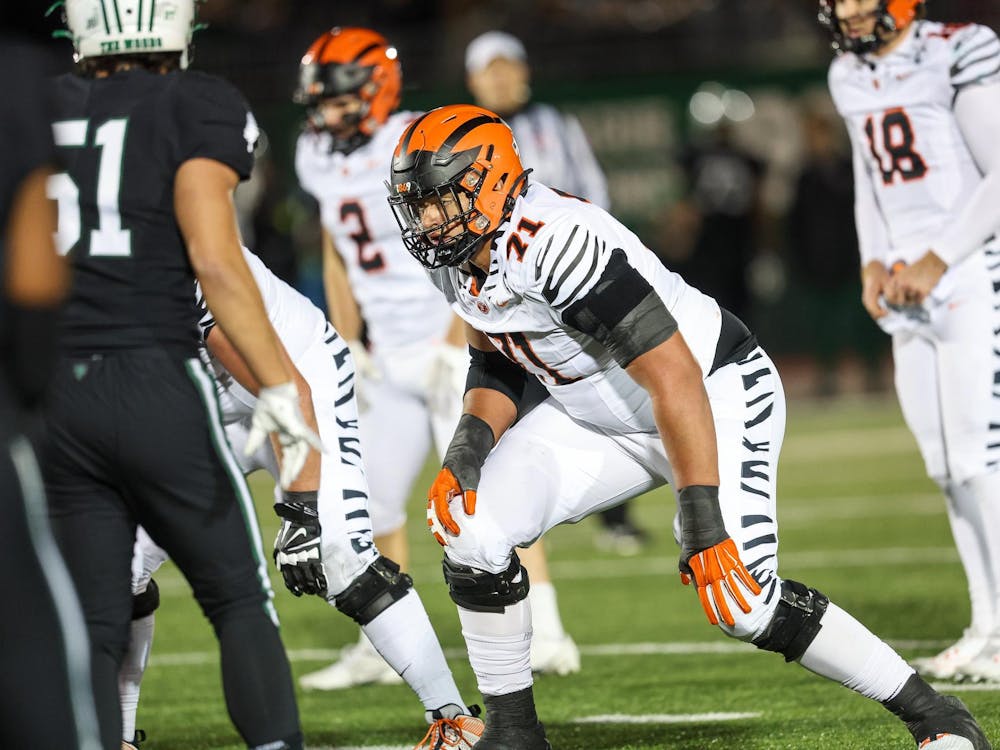In the ninth minute of the men’s soccer team’s nationally televised home game against Creighton last week, senior defender Mark Linnville perfectly executed one of Princeton’s most important assets: the long throw-in. His driven toss from the sideline sailed into the box, grazing the head of sophomore forward Cameron Porter before sophomore midfielder Myles McGinley slotted the loose ball into the back of the net, giving Princeton an early lead.
That goal marked just one of many such chances created this season by Linnville’s unique ability, allowing the team to create dangerous scoring opportunities from any throw-in in the attacking third of the field.
“He has the ability to pick out targets in the box and is very accurate with his throws,” head coach Jim Barlow ’91 said. “A lot of teams have a long throw, but Mark’s is probably the most dangerous we have seen in that it’s a line drive and can find a target with good accuracy.”
The women’s soccer team is also lucky to have a player who can consistently find the box with long throw-ins. Sophomore forward Liana Cornacchio’s lengthy toss in the team’s Ivy League opener against Yale on Sept. 22 gave the Tigers an overtime victory. After climbing back from an early 1-0 deficit to force overtime, Princeton emerged victorious when Cornacchio’s throw was mistakenly headed into the back of the net by a Yale defender.
“We got a little bit of luck with the own goal,” senior defender Alison Nabatoff told the Daily Princetonian after the game. “But Liana has a really dangerous throw-in — you never know what is going to happen. She can throw it all the way into the box.”
Surprisingly, neither Linnville nor Cornacchio can remember precisely how or when they first acquired this talent.
“I am not really sure how it first developed, but ever since I was in about seventh grade, I have been throwing the ball in for my team,” Linnville said.
Cornacchio agreed, saying that she has been able to do it ever since she started playing competitive soccer.
Furthermore, neither player ascribes to any specific training regimen in order to produce the deep throw-ins. Cornacchio, who swam competitively when she was younger, admits that she may have developed extra strength from that training. Still, besides some simple arm stretches before the game, both athletes seem to rely on a combination of innate ability and general soccer knowledge.
“I used to just chuck it in and see what could happen in there, whereas now, there is a bit more intelligence to the throw, as in trying to find [senior midfielder Matt] Sanner’s head or actually picking out a person when I am trying to throw it in,” Linnville said.
Both head coaches hailed the value of their players’ abilities. Women’s head coach Julie Shackford said she believes that Cornacchio’s ability distinguishes her from other throwers in the league.
“I do think a lot of teams have a long thrower, but I’m not sure players can drive the ball with the force she does,” Shackford said.

Barlow said that sometimes he even prefers a Linnville throw-in to a corner kick. “Lately we have been pretty dangerous on both corners and long throws,” he said. “But Mark’s throws have been so consistent, it is probably a little easier for the guys in the box to get on the end of the throw.”
With every toss capable of creating a scoring opportunity, the teams have been keen on taking advantage of every chance. Although neither team possesses specific throw-in plays, both focus on certain key elements. Shackford said her main focus is making sure that players get aggressive in the box.
Barlow said his team puts an emphasis on what comes after the initial throw. McGinley’s goal against Creighton came on the second touch after a long toss, as did Porter’s goal against Brown on Oct. 6.
“The key part is making sure the guys are ready for the flick-on or redirection, and we have been very dangerous with that part recently,” Barlow said.
Perhaps most importantly, long throw-ins can put a burden on the opposing team.
“It can be pretty devastating at times for the defense to do a good job defending and to knock the ball out of bounds, only to have it turn into a corner-like chance,” Linnville said. “I am sure it has to be annoying as a defender for the other team.”







